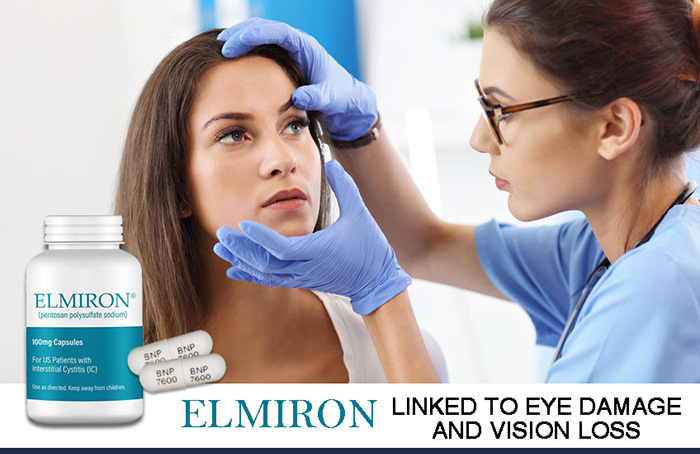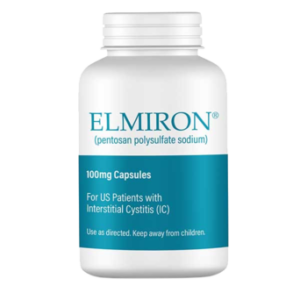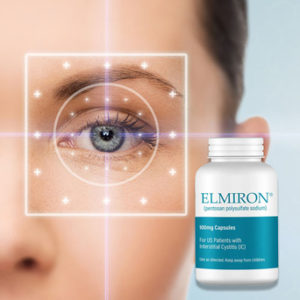



 Your vision is irreplaceable. Your eyes are what allow you to see the world and to perceive all the things that make up your world – things like a smile on a friend’s face and your favorite photos of treasured family moments. Without your vision, you would lose your independence, your ability to enjoy so many parts of life, and so much more.
Your vision is irreplaceable. Your eyes are what allow you to see the world and to perceive all the things that make up your world – things like a smile on a friend’s face and your favorite photos of treasured family moments. Without your vision, you would lose your independence, your ability to enjoy so many parts of life, and so much more.
That’s why it’s so alarming that a medication that was thought to be safe – for decades – has now been linked to serious eye problems that could progress to complete blindness. Hearing the disturbing news on an Elmiron lawsuit commercial may have caused you to wonder if there’s a link between the drug you take for painful bladder symptoms and the visual impairments that you’ve developed.
It’s a definite possibility, supported by research so strong that it led the FDA to add a new warning to Elmiron’s product label. If you have any reason to think that taking Elmiron could have contributed to your vision problems, you may be able to pursue a claim for financial compensation.
Your vision problems turned your life upside down. Now that you know a pharmaceutical manufacturer could be to blame, you can and should hold them accountable for the harm they’ve caused you.
To take the first step toward getting the money you and your family need to cope with a serious visual impairment, call (866) 778-5500 today.
Table of Contents
An Elmiron lawsuit is a legal claim for compensation filed by a patient who took the medication Elmiron and subsequently suffered serious vision problems.
The most serious vision problem caused by Elmiron – blindness – can change your life in ways that no amount of money can truly make up for. But getting every dollar of compensation available to you for an Elmiron vision loss claim can, at least, help you pay for the medical expenses and the major adjustments needed to move forward with life after vision loss.
The dangers of Elmiron vision changes have only recently become public knowledge. For most of the drug’s 20+ years on the market, it was considered relatively safe. Research presented by ophthalmologists in 2018 and subsequently expanded upon at the 2019 Annual Meeting of the American Academy of Ophthalmology was what finally sounded the alarm that Elmiron could be linked to irreversible vision damage.
Despite the news of vision issues being linked to Elmiron, the FDA did not recall the medication in 2019 or throughout 2020. Only midway through 2020 did the FDA finally update the Elmiron warning label to reflect these frightening new reports. All that time, patients taking Elmiron remained at risk of developing new or worsening vision changes because of the medication.
If you believe there’s any chance that taking Elmiron led to your eye damage or vision loss, you need to speak to an experienced pharmaceutical injury law firm right away. There’s a deadline to move forward with an Elmiron vision lawsuit. The clock is ticking.
 Elmiron is a prescription drug that was approved by the FDA in 1996. The primary use for Elmiron is urology, a medical specialty that focuses partly on the urinary tract of both male and female patients.
Elmiron is a prescription drug that was approved by the FDA in 1996. The primary use for Elmiron is urology, a medical specialty that focuses partly on the urinary tract of both male and female patients.
Elmiron is a brand name. The Elmiron generic name is pentosan polysulfate sodium (PPS). As of 2020, however, there are no generic Elmiron alternatives on the market in the United States.
The makers of Elmiron, Janssen Pharmaceuticals – part of Johnson & Johnson – enjoy the benefits of having the only drug on the market approved specifically to treat a urological condition known as interstitial cystitis (IC).
Chief among these benefits is reaping all of the profits – estimated to be as high as $150 million per year – without having to share them with generic manufacturers or competing drugmakers.
Elmiron’s drug class is a mild anticoagulant, otherwise known as a weak blood thinner. As a blood thinner, Elmiron works at about 1/15th the level of activity of the anticoagulant medication heparin.
Elmiron was initially approved as an orphan drug, a drug that is awarded special treatment for its use in treating rare diseases. However, Elmiron is widely used.
Under the Orphan Drug Designation program, a disease is considered rare if it impacts fewer than 200,000 patients in the United States. But IC, the primary indication for this drug, is now thought to affect between 700,000 and 1 million Americans, the University of Rochester Medical Center reported. Further, the clinical use of the drug has expanded well beyond its initial approved purpose, researchers reported in the journal Food and Chemical Toxicology.
Despite research suggesting that as many as one-quarter of long-term Elmiron users develop retinal damage, there has been no Elmiron recall as of November 2020.
The only change has been a warning – not a black box warning, just a regular warning – of retinal pigmentary changes added to the Elmiron label. This revision wasn’t complete until June 2020, nine months after the American Academy of Ophthalmology presentation that publicly shed light on the risk and more than two years after the first published research study linking Elmiron to retinal damage.
The bladder conditions and urinary symptoms that Elmiron is used to treat can affect both men and women. However, women are more likely to take Elmiron, since females make up 90 percent of patients with IC, according to the University of Rochester Medical Center.
Although patients often develop early symptoms at a younger age, the average age of IC diagnosis is 40. As a result, patients taking Elmiron are often, though not always, 40 or older.
 Recent research linking Elmiron and eye issues has done more than just call into question the safety of this medication. This discovery has brought about a wave of Elmiron lawsuits on behalf of patients who might otherwise have never connected the medication they take for their urinary symptoms to their devastating vision loss.
Recent research linking Elmiron and eye issues has done more than just call into question the safety of this medication. This discovery has brought about a wave of Elmiron lawsuits on behalf of patients who might otherwise have never connected the medication they take for their urinary symptoms to their devastating vision loss.
If you have taken Elmiron in the past and went on to suffer disorders of the retina or other eye damage, you need to know that the drug could be the cause of your vision changes. And, if you’re still taking Elmiron, it’s important to speak to your doctors as soon as possible.
In light of this information, you should discuss with your urologist whether to continue or stop taking the drug and work with an ophthalmologist to evaluate any changes in your vision.
Elmiron is prescribed to reduce pain and discomfort for certain conditions, typically related to the bladder and urinary tract. Despite being on the market for more than two decades, not much is known about how Elmiron works, and some studies have cast doubt on whether the drug works at all.
The official use of Elmiron, according to the FDA, is “to treat the pain or discomfort of
interstitial cystitis.” In clinical practice, though, the drug is often prescribed to attempt to treat other symptoms or conditions.
Elmiron’s uses include:
Whether you’re taking Elmiron for IC, bladder pain, UTI, or another purpose, the risk of vision loss – especially with long-term use – is a cause for concern.
As with all medications, the question comes down to whether the benefits of taking the drug outweigh the risks. Vision loss is a big risk, and even before the link between Elmiron and eye issues was discovered, researchers had questioned the drug’s effectiveness.
The condition for which patients are most commonly prescribed Elmiron, interstitial cystitis, is a condition that affects the bladder and the urothelium, the lining of the lower urinary tract. Some of the symptoms that a person diagnosed with IC may have – although not everyone has every symptom – include:
One difference between interstitial cystitis and non-IC diagnoses of overactive bladder is that, in IC, the urothelium lining can actually change to become more permeable.
What does Elmiron do for the bladder? The drug is prescribed to eliminate some of the pain and discomfort caused by IC, but exactly how it accomplishes this isn’t well understood.
The Elmiron mechanism of action – how it achieves its intended results within the body – “is not known,” according to the FDA.
Elmiron manufacturer Janssen Pharmaceuticals explains in slightly more detail that “it is not known exactly how ELMIRON works, but it is not a pain medication like aspirin or acetaminophen and therefore must be taken continuously for relief as prescribed.”
Further, the drugmaker notes that “although how ELMIRON works is not completely understood, it is thought to adhere to the bladder mucosal lining, preventing potentially irritating solutes in the urine from reaching the bladder wall.”
There is no cure for interstitial cystitis. Elmiron doesn’t cure the disease. It’s prescribed only to help manage symptoms.
How well the drug succeeds in alleviating IC symptoms is unclear. In a study published in The Journal of Urology in 2014, researchers concluded that “there was no statistically significant difference between the pentosan polysulfate sodium group and the placebo group” and that the data “revealed no treatment effect vs placebo.”
It can take three, six, or even twelve months of use to see improvement from taking Elmiron. This lag time adds to the difficulty of determining whether the drug works for you or whether it could be exposing you to side effects and risks – potentially including serious vision changes – for little benefit.
Why take Elmiron if it could pose some serious risks and may not offer a statistically significant improvement? That’s a question the dozens of plaintiffs in Elmiron lawsuits are asking. In these filed lawsuits, plaintiffs have alleged that Elmiron’s manufacturer failed to warn doctors and patients of the risks of eye damage.
Virtually all medications have the potential to cause side effects or adverse reactions. The most common Elmiron risks, according to the FDA, are:
The concerning evidence presented by researchers and ophthalmologists suggests that Elmiron may cause vision problems that could lead to blindness.
 Even before researchers identified a risk of retinal pigmentary damage, there were some known Elmiron side effects related to eye issues. These side effects include:
Even before researchers identified a risk of retinal pigmentary damage, there were some known Elmiron side effects related to eye issues. These side effects include:
The Elmiron vision problems that came to light through research presented in 2018 and 2019 involved a type of maculopathy known as retinal pigmentary change.
Maculopathy is the medical term for any type of disease or disorder of a part of the eye called the macula. The macula is an area located at the center of the retina that, when functioning normally, is what gives you accurate, high-resolution vision. Damage to the macula can interfere with the clarity and accuracy of your vision.
There are a few different types of maculopathy:
The type of maculopathy that has been linked to Elmiron is sometimes referred to as “pigmentary maculopathy of unknown etiology.” Beyond its reported link to Elmiron, this form of macular damage has no known cause.
Prior to the research findings that connected Elmiron use to retinal pigmentary changes, patients with this condition were often considered to have “pattern dystrophy,” according to researchers highlighted by the American Academy of Ophthalmology.
Some of the signs that characterize Elmiron maculopathy include:
An ophthalmologist – a medical doctor that specializes in eye and vision care – can identify the signs of Elmiron maculopathy through a thorough eye exam. However, you might not be able to recognize these signs yourself.
Instead, you’re likely to notice symptoms that may include any of the following:
Having one or more of these symptoms doesn’t necessarily mean you have developed Elmiron maculopathy or that your vision problems will progress to complete blindness. However, if you notice vision changes or visual disturbances and take (or previously took) Elmiron, please contact both an ophthalmologist and your urologist.
You need to work with your medical professionals to diagnose your vision trouble and make an informed decision as to whether to continue taking Elmiron and what testing procedures and alternative therapies may be available.
In June 2020, the FDA updated Elmiron’s label to include a warning of pigmentary changes in the retina, also called pigmentary maculopathy.
Symptoms noted in the revised FDA warning include:
The warning states that most cases of retinal pigmentary changes in Elmiron users happened when using the drug for three years or longer and that cumulative dose of the medication may be a risk factor. Given that IC is a chronic condition and that many patients are on Elmiron for several years, this data can seem less than reassuring.
Further, the FDA also acknowledges that “cases have been seen with a shorter duration of use.”
Under the new FDA warnings, patients using Elmiron should have a detailed ophthalmologic history taken prior to starting this treatment. They should also undergo a baseline retinal examination within six months of beginning Elmiron therapy. Patients with pre-existing ophthalmologic conditions or a family history of ophthalmologic conditions may wish to consider other testing and weigh their unique risks against the expected benefits of the drug.
In the most serious cases of Elmiron and macular degeneration, a patient can completely lose their vision. Unfortunately, blindness that is associated with Elmiron use may be irreversible.
For unsuspecting patients, it’s mind-boggling that taking Elmiron for your bladder symptoms can lead to permanent vision loss. If you’d known about the connection between Elmiron and maculopathy, there’s a good chance you wouldn’t have taken the drug to begin with. If you did make an informed choice to take the medication despite the risk, you definitely would have been more aware of the need for regular vision checks and eye exams.
The FDA’s warning about the Elmiron effects on eyes can, at least, help prevent new instances of life-changing vision loss. However, this warning comes too late to help patients who have already sustained serious and irreversible Elmiron eye damage.
How does Elmiron cause macular degeneration? Researchers from the American Academy of Ophthalmology published findings in 2019 stating that the drug “appears to be toxic to the retina.”
Rates of ocular toxicity increased with the amount of Elmiron patients took, affecting just 11 percent of patients taking a lower dose (between 500 and 1,000 grams) of the drug but 42 percent of patients taking a high dose (at least 1,500 grams), researchers concluded.
 When you’ve suffered from Elmiron eye disease, you have a right to hold the manufacturer of the drug accountable for the harm you sustained. The way patients have done this is by filing Elmiron lawsuits to seek compensation.
When you’ve suffered from Elmiron eye disease, you have a right to hold the manufacturer of the drug accountable for the harm you sustained. The way patients have done this is by filing Elmiron lawsuits to seek compensation.
When determining if you have a case, and how strong that case is, an Elmiron attorney will look at certain criteria, including:
Your answers to these questions will help attorneys handling Elmiron lawsuits determine if they may be able to help you and what the next steps are for your case.
Elmiron eye damage doesn’t occur instantly. Instead, it appears to develop over time and exposure to the medication. As a result, an attorney will need to know how much Elmiron you have been exposed to.
Generally, most of the Elmiron users currently suing over vision loss from the drug took Elmiron for at least two years. Some users have taken the medication for decades, nearly since the drug was first approved for the market.
Although the length of time during which you took Elmiron matters, it’s not the only factor to consider. The FDA noted that “cumulative dose appears to be a risk factor” for developing retinal pigmentary changes. A patient who took a high dose of Elmiron for three years may be considerably more likely to have suffered vision loss than a patient who took a low dose for the same span of time.
Many people don’t have perfect vision, especially as they age. When someone develops vision problems that may be attributed to Elmiron, these problems usually arise either while taking Elmiron or within a year of stopping the medication.
The reason for this window of time because “retinal and vision changes may progress even after cessation of treatment,” the FDA reported. However, if the vision loss occurs too long after you stopped taking Elmiron, it becomes less likely that the drug is the cause or that sufficient evidence exists to prove Elmiron’s impact.
Even though there is now a documented link between Elmiron and eye damage, you need more to pursue a claim than your own report that you don’t see as well. You will need to have an eye doctor document the vision symptoms and changes you suffered in your medical notes. A doctor may diagnose vision issues through a combination of asking you about your visual symptoms and performing an eye exam and diagnostic tests.
In most Elmiron eye damage lawsuit cases, the plaintiff (or their doctor) reported injuries and symptoms like the following:
If you have any unusual vision loss or changes after taking Elmiron, it’s worth speaking to an attorney about your situation. However, for the sake of both your claim and your health, you need to see an eye doctor.
Having your vision issues properly diagnosed can help you take steps to preserve what’s left of your vision, determine if you need to explore alternatives to Elmiron, and get an informed opinion from an Elmiron lawyer about your case.
You may already know that there are different types of legal matters – not only civil versus criminal matters but also different areas within the practice of civil law. Matters of personal injury law are distinct from matters of family law, estate law, contract law, and other areas.
What you might not know is that different types of personal injury cases are handled differently. If your injuries and the negligence that caused them are unique, then you most likely have an individual personal injury claim on your hands. In cases in which numerous plaintiffs develop the same kinds of injuries from the same defects or dangers, the result may be a large class-action lawsuit that represents each individual plaintiff in one legal action.
It’s a common misconception that, if you suffered vision loss from taking pentosan polysulfate sodium, you have an Elmiron class-action lawsuit. Although some lawsuits have been filed that could potentially be handled as class action claims, it’s too soon to know whether any Elmiron cases in the United States will be pursued as a class-action lawsuit. As of November 2020, it’s looking likely that many plaintiffs who are pursuing Elmiron claims will see their individual cases consolidated into multidistrict litigation (MDL) cases.
Although it may seem like splitting hairs, there are important differences between MDL claims, class action lawsuits, and individual personal injury claims. MDL claims combine some of the advantages that accompany a class action lawsuit with the focus on one plaintiff’s unique damages that you would find in an individual personal injury claim.
In MDL, you file your own individual claim rather than being part of one large claim. This means you work with your own attorney and, if your case goes to court, you would have your own trial.
However, because your claim is consolidated and transferred to a court that oversees all claims in the multidistrict litigation, these pre-trial proceedings – such as the discovery phase where evidence is gathered – can be handled more conveniently, saving time and money for all parties involved.
The Elmiron cases currently filed in the U.S. – around 80 of them, as of November 2020 – are likely to be consolidated into MDL. In October 2020, the United States Judicial Panel on Multidistrict Litigation gave notice that a hearing would be held on December 3, 2020, to determine whether an Elmiron MDL would be created and, if so, in which jurisdiction it would be held.
In the meantime, victims of Elmiron ophthalmic side effects can still move forward with contacting an attorney about their claim. Our Elmiron lawyers are preparing for whatever changes and challenges lie ahead and will work to get you results through an individual personal injury claim or through multidistrict litigation.
If you think you meet the Elmiron lawsuit criteria – or even if you think you might meet the criteria – then your next step is clear. You need to talk to an attorney.
Janssen Pharmaceuticals and its parent company, Johnson & Johnson, are large, influential companies with no shortage of resources. Companies like these routinely employ their own legal teams to minimize their financial obligations in matters like yours. This isn’t the kind of claim that you can attempt to handle yourself – not if you want to get results.
Having an attorney on your side in any legal matter is invaluable, but your lawyer is even more crucial when the defendant is a big corporation and the stakes are this high.
Getting legal representation on your side is a lot easier than you might believe. All it takes is a phone call to initiate a free, confidential consultation.
Our Elmiron lawsuit lawyers will ask you questions about your vision problems and your history of Elmiron medicine use. We’ll also answer your questions – about your legal rights, the lawsuit process, paying for the medical care you need, and more.
If we feel that we can help you, then we will offer to take your case on a no-win, no-fee basis. This means you pay nothing upfront for legal representation and nothing at all unless we succeed in getting you an Elmiron lawsuit settlement or jury award. We can help you conveniently sign up for our legal representation with a remote intake process.
Once you retain our services, our Elmiron lawyers will immediately get to work on your case. We know you need help navigating this situation – and that, in some instances, you might be unsure about how to go about getting or paying for medical care. And we want to know, whether your Elmiron claim is handled as an individual personal injury case or consolidated into MDL, that we’ve started off your case the right way, with a thorough investigation.
 If you suffered from Elmiron vision issues, it’s important to make the FDA aware of these adverse events. Reports of adverse events are, at least in part, what prompts the FDA to add new warnings to the labels of existing drugs and to issue recalls.
If you suffered from Elmiron vision issues, it’s important to make the FDA aware of these adverse events. Reports of adverse events are, at least in part, what prompts the FDA to add new warnings to the labels of existing drugs and to issue recalls.
Both patients and medical professionals can report adverse effects of medication to the FDA. There are several ways you could go about reporting your side effects to the agency.
Reporting your Elmiron vision damage and side effects to the FDA serves an important purpose. But it doesn’t negate your need for compensation. Whether or not you report your adverse event to the FDA, you need to pursue an Elmiron injury claim to get the money you deserve.
How much could you get from your Elmiron claim? Since these cases are still in the early stages of litigation, there aren’t yet any Elmiron lawsuit settlement amounts available. No cases have been resolved as of November 2020.
What we can tell you is that the compensation you receive for any pharmaceutical injury or personal injury matter is determined by your damages. When the drug has caused you to develop serious vision changes, there’s no question that the extent of your damages is massive. You deserve an Elmiron settlement that fully covers those damages.
In the legal industry, the term “damages” refers to all of the various types of harms and losses that you suffered. The point of a personal injury claim is to compensate, or repay, you for those harms, even if they weren’t strictly financial in nature.
The damages you might pursue in an Elmiron lawsuit generally fit into one of two categories: economic and non-economic.
Your economic damages are the ones that come with a clear numerical price tag. Although you may need to make projections to calculate these costs for the future, they are losses that can be easily quantified into a monetary value.
Economic damages in Elmiron claims may include:
You know better than anyone that the ability to see is priceless. No amount of money can ever truly make up for losing your vision and all that you lose as a result. These harms that are so difficult to quantify are considered non-economic damages, and you deserve compensation for them.
The non-economic damages for which you can seek Elmiron compensation include:
When you work with an attorney, you’re giving yourself the chance to obtain the largest Elmiron lawsuit amount possible for your situation. Generally, attorneys get their clients 3.5 times more money than claimants without a lawyer get for themselves – and recovering compensation at all without a lawyer is an uphill battle when you’re facing off against a major pharmaceutical company.
Your attorney’s pay for representing you is tied to the amount of compensation you win in an Elmiron settlement or jury award. That means your lawyer’s goals for your lawsuit are always aligned with yours: to get the maximum compensation for your claim.
It’s time to take the next step – and that means taking advantage of a free and confidential Elmiron case evaluation.
The different checklists of Elmiron eye side effects and criteria for the length of Elmiron use and the timing of your eye injury diagnosis have their uses. But these resources can only take you so far. If you think you may have a case, you need to get in touch with a lawyer.
Our Elmiron attorneys offer free, no-obligation consultations. You’ll talk to a legal professional about your situation and have the chance to ask whatever questions you may have. There’s no pressure and no cost.
If you decide you don’t want to move forward with a claim, that’s okay – and if you do want our help standing up for your legal rights, we won’t charge you anything upfront for our services.
Get your Elmiron claim started today. Just call (866) 778-5500 for your free consultation.
The FDA approved Elmiron for use on the United States market in September 1996 under its Orphan Drug Designation program. At the time, the label contained no warning about Elmiron pigmentary maculopathy, because this adverse effect wouldn’t be discovered for more than 20 years.
By 1997, eye problems occurring with Elmiron use were already being reported to the FDA. The FDA Adverse Events Reporting System (FAERS) received 2,382 reports of adverse events occurring in patients taking Elmiron. Of those, 1,545 were “serious cases,” including deaths.
In 2014, research published in The Journal of Urology cast doubts on whether the drug was effective for treating IC. In this study, researchers found “no statistically significant difference” and “no treatment effect vs placebo.”
That’s a drastic departure from research published in 1997, shortly after Elmiron was approved, that concluded that the drug was “an efficacious long-term treatment for reducing a constellation of debilitating symptoms.”
In 2018, a team of ophthalmologists first reported in Ophthalmology (the journal of the American Academy of Ophthalmology) about their discovery of a novel type of maculopathy that had affected six Elmiron users between 2015 and 2017.
The lead author of the study, Dr. William Pearce of the Georgia Eye Institute, noted that “it is important that clinicians are aware of this association when evaluating patients with macular dystrophy or degeneration, as it could easily be overlooked due to the subtle findings.”
Researchers continued to explore the connection between vision issues and Elmiron throughout 2019. Published findings on Elmiron in 2019 included an April 2019 article in The Journal of Urology, an October 2019 article published in the journal Ophthalmic Surgery, Lasers & Imaging Retina, and a November 2019 article published in The British Journal of Ophthalmology.
Perhaps the most concerning data to emerge in 2019 about Elmiron causing eye problems came from ophthalmologists Robin A. Vora, Amar P. Patel, and Ronald Melles. As an American Academy of Ophthalmology news release reported, this study revealed that around one-quarter of patients who had undergone “significant exposure to Elmiron” displayed “definite signs of eye damage.”
Research studies on Elmiron retinal damage kept pouring in throughout 2020. These studies included a January 2020 article published in the Canadian Journal of Ophthalmology, a February 2020 article published in the Canadian Urological Association Journal, and an August 2020 article published in The British Journal of Ophthalmology.
The FDA was “evaluating the need for regulatory action” when the agency’s July-September 2019 report was released. But it wasn’t until June 2020 that the FDA finally published a revised Elmiron label that included a warning about retinal pigmentary changes.
The first Elmiron lawsuit filed – on March 26, 2020 – was on behalf of Kimberly Pelczar, who took the medication for ten years before she started to experience visual symptoms that progressed to permanent vision loss, according to The National Law Review. Pelczar’s Elmiron suit named Teva Pharmaceuticals USA Inc., as well as Janssen Pharmaceuticals.
On May 4, 2020, plaintiff Tina Pisco filed an Elmiron lawsuit over the permanent retinal injury she sustained after six years of taking the medication to treat interstitial cystitis, The National Law Review reported. Another plaintiff, Valerie Hull, filed her Elmiron claim on June 8, 2020, after 17 years of taking the medication left her with severe vision loss. Hull had been part of the original study that, in 2018, led to the discovery of this new form of maculopathy.
As of November 2020, more than 80 Elmiron lawsuits had been filed across the United States. Considering the number of patients who took Elmiron treatment for interstitial cystitis over the decades the drug was on the market, it’s likely that the number of lawsuits will continue to climb as the link between the bladder drug and vision loss becomes more widely publicized.
Generally, these lawsuits allege that Elmiron’s manufacturer was negligent in failing to properly warn users, physicians, and the general public about the risk of vision problems.
Will there be an Elmiron recall in late 2020 or 2021? Will the FDA add an Elmiron black box warning – the strongest warning the agency issues on a drug that’s still on the market – that highlights the severity of the drug’s alleged potential to cause vision loss?
It’s too soon to tell, but experienced Elmiron lawyers are watching closely for the next developments and advocating tirelessly for the victims harmed by pigmentary maculopathy. Whatever comes next, we’ll be ready for it.
Elmiron attorneys handle claims on a no-win, no-fee basis. This means that you owe nothing for your legal representation unless and until your attorney succeeds in getting you compensation.
You won’t be billed an hourly rate or a monthly retainer, so it doesn’t matter how much time your legal team has to put into building a case that gets the outcome you deserve.
Whether your case is handled as an individual personal injury lawsuit, part of Elmiron MDL, or part of an Elmiron class-action lawsuit, the attorneys’ fees you have to pay will come out of the money you win and be based on the results your lawyer gets for you. You never have to worry about spending more to pursue your case than it is actually worth or ending up with an out-of-pocket bill for legal representation.
The harm you suffered due to Elmiron ocular side effects will impact your life for a long time – possibly forever. You don’t have nearly as long to decide to move forward with a claim.
If you don’t take action soon, you could miss out on your opportunity to hold Janssen Pharmaceuticals and Johnson & Johnson accountable. In personal injury claims, there is a deadline, known as the statute of limitations, that restricts your right to sue. Miss this deadline, and you may never get the money you need to make the best possible recovery from Elmiron macular degeneration.
The statute of limitations for claims involving defective pharmaceutical products varies from state to state. In some states, it can be as short as one year from the time you noticed symptoms or became aware of the connection between your symptoms and your Elmiron use.
Even if you have more time, you don’t want to wait too long to reach out to an attorney. Compiling documentation of your vision damage, Elmiron medication use, and damages and then going through the process of filing a lawsuit can take time. Waiting until the last minute to get started could cause important information to be missed or fall through the cracks. The earlier your attorney can get started preparing your claim, the better.
Is it ever too soon to reach out to an attorney handling Elmiron claims? Not necessarily. A lawyer will be able to give you more definitive answers about the likelihood of your claim’s success at a certain point, such as after you have gotten an official diagnosis from an ophthalmologist who is familiar with the Elmiron vision loss risk. However, we are also happy to help you get the ball rolling on getting a diagnosis if you don’t know what steps to take next.
When you reach out to a law firm handling Elmiron maculopathy claims, we start taking action to build your case right away. That includes steps like the following:
Having an Elmiron lawsuit attorney means having an advocate on your side from the day you hire us to the day your case resolves. You might be surprised at the kinds of problems we can assist with, so if you’re struggling, let us know. We’ll see how we can help.
